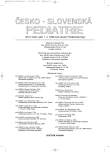Kawasaki Disease (40th Anniversary of the First Publication)
Authors:
J. Gut
Authors‘ workplace:
Dětské oddělení NsP, Česká Lípa
primář MUDr. J. Gut
Published in:
Čes-slov Pediat 2008; 63 (3): 156-163.
Category:
Postgraduate Education
Overview
Acute vasculitis of medium arteries – Kawasaki disease – is not a rare illness even in our geographical conditions, although it clearly predominates in the Japanese population. In most cases there is a spontaneous decline in clinical picture symptoms, but without any therapeutic intervention the disease represents a 20 – 25% risk of affected coronary arteries with acute and chronic consequences. The administration of high doses of immunoglobulins is clearly a method of choice, which significantly decreases the risk. The diagnostic pitfalls represent incomplete forms, especially in infants. In this age there is a greater risk of coronary lesions.
Key words:
Kawasaki disease, incomplete forms, coronary aneurysms, intravenous immunoglobulins
Sources
1. Deodoglu F, Sundel R. Vasculitis in children. Pediatr. Clin. North. Am. 2005;52: 547–575.
2. Duronggpisistkul K, et al. The prevention of coronary aneurysm in Kawasaki disease. A metanalysis on the efficacy of aspirin and imunoglobulin treatment. Pediatrics 1995;96: 1057–1061.
3. Fischer P, Uttenreuther-Fischer M. Kawasaki disease: update on diagnosis, treatment and a still controversial etiology. Ped. Hematol. Oncol. 1996;13: 487–501.
4. Fukunishi M, et al. Prediction of non responsiveness to intravenous high dose gamma globulin therapy in patients with Kawasaki disease at onset. J. Pediatr. 2000;137: 172–176.
5. Fukushige J, Takahashi N, Ueda Y. Incidence and clinical features of incomplete Kawasaki disease. Acta Pediatr. Scand. 1994;83: 1057–1060.
6. Furusho K, et al. High dose intravenous gamma globulin for Kawasaki disease. Lancet 1984;2: 184–192.
7. Gut J. Quo vadis, Kawasaki, v roce 1994. Čes.-slov. Pediat. 1995;9: 538–542.
8. Helin I, Oskarson G. Prolonged fever, thrombocytosis and coronary aneurysma – incomplete Kawasaki disease or separate entity? Eur. J. Pediatrics 1998;157: 473–474.
9. Chang FY, Hwang B, et al. Characteristics of Kawasaki disease in infants younger than six months. Pediatr. Infect. Dis. J. 2006;25(3): 241–244.
10. Kawasaki T. Acute febrile mucocutaneous syndrome: clinical observation of 50 cases. Jpn J. Allergy 1967;16: 178–222.
11. Kogulan P, Mbualungu E, Villanueva E, et al. Kawasaki syndrome in an adult. Case report and review of the literature. J. Clin. Rheumatol. 2001;7: 194–198.
12. Kouřim J, Schlegerová D. Kawasakiho syndrom a infantilní polyarteriitis nodosa. Čs. Pediat. 1981;36(2): 79–82.
13. Kuijpers TW. A boy with chickenpox whose fingers peeled. Lancet 1998;351: 1782.
14. Leung D. Kawasaki disease. Curr. Opin. Rheumatol. 1993;5: 41–50.
15. McMaster P. Is it Kawasaki disease? J. Pediatr. Child. Health 2000;36: 506–508.
16. Mori M, et al. Predictors of coronary artery lesions after intravenous gammaglobulin treatment in Kawasaki disease. J. Pediatr. 2000;137: 177–180.
17. Newburger JW. Kawasaki disease: Who is at risk? J. Pediatr. 2000;137: 149–152.
18. Newburger JW, et al. Diagnosis, treatment and long term managment of Kawasaki disease. A statement for health professionals from Committee on Rheumatic Fever, Endocarditis and Kawasaki Disease 2004. Council on Cardiovascular Disease in the Young, American Heart Association.
19. Newburger JW, Sleeper L, McCrindle BW, et Pediatric Heart Network Investigators. Randomized trial of pulsed corticosteroid therapy for primary treatment of Kawasaki disease. N. Engl. J. Med. 2007;356: 663–675.
20. Oates-Whitehead RM, et al. Intravenous gamma globulin for the treatment of Kawasaki disease. Cochrane Database Syst. Rev. 2003;(4): CD004000.
21. Stanley TV, Grimwood K. Classical Kawasaki disease in neonate. Arch. Dis. Child. 2002;86(2): 135–136.
22. Sundel R, Burns J, Baker A, Newburger J. Gamma globulin retreatment in Kawasaki disease. J. Pediatr. 1993;123: 657–659.
23. Terai M, Hulman S. Prevalence of coronary artery abnormalities in Kawasaki disease is highly dependend on gamma globulin but independent of salicylate dose. J. Pediatr. 1997;131: 888–893.
24. Wang J, Chiou Y, Chiu N, Chen M. Renal scarring sequelae in childhood Kawasaki disease. Pediatr. Nephrol. 2007;22(5): 684–689.
Labels
Neonatology Paediatrics General practitioner for children and adolescentsArticle was published in
Czech-Slovak Pediatrics

2008 Issue 3
Most read in this issue
- Tularaemia: Rare Cause of Fever and Lymphadenopathy in an Infant
- Plasmapheresis and Immunoadsorption in Pediatrics
- Czech Atherosclerosis Society Guidelines for the Diagnosis and Treatment of Dyslipidemias in Children
- Kawasaki Disease (40th Anniversary of the First Publication)
